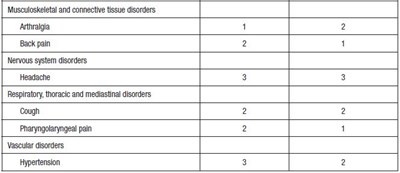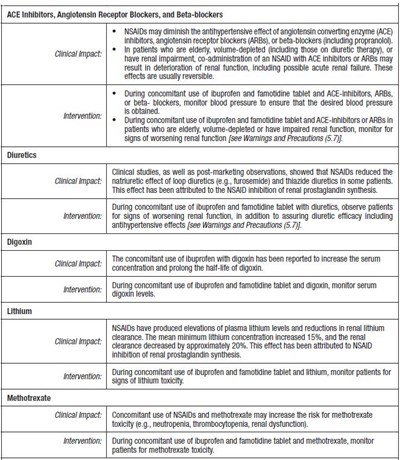Product Images Ibuprofen And Famotidine
View Photos of Packaging, Labels & Appearance
- 5.11 - 5.11
- 5.14 - 5.14
- CL-30s count.jpg - CL 30s count
- Ibu-struct.jpg - Ibu struct
- MG 1 - MG1
- MG 2 - MG2
- MG 3 - MG3
- MG 4 - MG4
- famotidine-struct.jpg - famotidine struct
- table 1 - table 1
- table 2.2 - table 2.2
- table 2.1 - table 2
- table 3.1 - table 3.1
- table 3.2 - table 3.2
- table 3.3 - table 3.3
- table 4 - table 4
- table 5 - table 5
Product Label Images
The following 17 images provide visual information about the product associated with Ibuprofen And Famotidine NDC 43602-544 by Ascent Pharmaceuticals, Inc., such as packaging, labeling, and the appearance of the drug itself. This resource could be helpful for medical professionals, pharmacists, and patients seeking to verify medication information and ensure they have the correct product.
5.11 - 5.11

This text describes the risks associated with the use of NSAIDs during pregnancy. Specifically, it states that using NSAIDs such as Ibuprofen and famoidine table after 30 weeks gestation may increase the risk of premature closure of the fetal ductus arteriosus. Additionally, using NSAIDs after 20 weeks gestation may be associated with fetal renal dysfunction leading to oligohydramnios and neonatal renal impairment.*
5.14 - 5.14

This text warns about the risks associated with maternal use of NSAIDs, including Ibuprofen, during pregnancy. The use of NSAIDs after 30 weeks of gestation may cause premature closure of the fetal ductus arteriosus. Maternal use of NSAIDs after 20 weeks of gestation has been associated with fetal renal dysfunction leading to oligohydramnios and neonatal renal impairment. Postmarketing studies and reports have some methodological limitations and preclude establishing reliable risk estimates. NSAID use to delay preterm labor may increase the risk of other neonatal complications like necrotizing enterocolitis and intracranial hemorrhage. Ibuprofen treatment in late pregnancy for delaying parturition has been linked to persistent pulmonary hypertension, renal dysfunction, and abnormal prostaglandin E levels in preterm infants.*
CL-30s count.jpg - CL 30s count

This is a medication label for an Ibuprofen and Famotidine Tablets bottle. It contains important information including dosage, administration, storage, manufacturer details and NDC number. It includes a note to pharmacists to dispense a Medication Guide to each patient.*
MG 1 - MG1

This text appears to be a warning about the potential risks and side effects associated with using certain medications, particularly NSAIDs (nonsteroidal anti-inflammatory drugs) and corticosteroids. These risks include an increased risk of stomach ulcers, intestinal bleeding, and bleeding problems. Factors that may increase the risk of experiencing these side effects include a past history of stomach ulcers or smoking, drinking alcohol, and advanced liver disease. The text advises being cautious while using these medications and seeking medical attention if any warning symptoms occur.*
MG 2 - MG2

This text contains a list of possible health issues, including heart attack, stroke, liver problems (including liver failure), new or worse high blood pressure, heart failure, kidney problems (including kidney failure), life-threatening allergic reactions, asthma attacks, life-threatening skin reactions, and low red blood cells (anemia).*
MG 3 - MG3
The text describes common symptoms that an individual might experience during a medical emergency. These include shortness of breath, slurred speech, chest pain, swelling of the face or throat, and weakness in one part or side of the body. Such symptoms can indicate the presence of a serious condition and require immediate medical attention.*
MG 4 - MG4

This text appears to be a list of symptoms that a person may experience. The symptoms include nausea, fatigue, diarrhea, itching, yellowing of the skin and eyes, stomach pain, flu-like symptoms, vomiting blood, bloody bowel movements, black and sticky stool, unusual weight gain, skin rash or blisters with fever, and swelling of the arms, legs, hands, and feet. These symptoms may be indicative of various health conditions, and it is recommended that a person experiencing these symptoms seeks medical attention to determine the underlying cause.*
table 1 - table 1

This is a table showing the shift of serum creatinine from normal to abnormal in controlled studies. The table includes data from two different studies (Study 301 and Study 303) and lists the number of participants in each group (famotidine tablet and ibuprofen and touprofen) as well as the percentage of participants whose serum creatinine levels became abnormal during the study period. Normal serum creatinine range was defined as 0.5-1.4 mg/dL or 44-124 micromol/L.*
table 2.2 - table 2.2

This text provides a list of various medical disorders categorized by their respective systems. Musculoskeletal and connective tissue disorders such as Atagia and back pain, nervous system disorders such as headaches, respiratory disorders such as cough, and pharyngolaryngeal pain are among the mentioned disorders. The list also includes hypertension, which is a vascular disorder.*
table 2.1 - table 2

Table 2 shows the incidence of adverse reactions in controlled studies for ibuprofen and famotidine tablets. The table includes the percentage of reported adverse reactions for each medication and the number of participants studied for each medication. Adverse reactions were reported for both medications, including anemia, gastrointestinal disorders such as nausea and diarrhea, and upper respiratory tract infections.*
table 3.1 - table 3.1

This is a description of the potential drug interactions of Ibuprofen and Famotidine. It explains that the concomitant use of Ibuprofen and anticoagulants may increase the risk of serious bleeding compared to using either drug alone. Additionally, the co-administration of drugs that interfere with serotonin reuptake and an NSAID may potentiate the risk of bleeding. The document recommends monitoring patients with concomitant use of Ibuprofen and Famotidine with anticoagulants, antiplatelet agents (such as aspirin), selective serotonin reuptake inhibitors (SSRIs), or serotonin-norepinephrine reuptake inhibitors (SNRIs), for signs of bleeding. The interaction between Ibuprofen and aspirin, especially for those taking aspirin for cardioprotection, is also discussed, and the use of an NSAID that does not interfere with aspirin's antiplatelet effect is suggested. It also states that Ibuprofen and Famotidine tablet is not a substitute for low-dose aspirin for cardiovascular protection.*
table 3.2 - table 3.2

This is a warning about the potential for negative interactions between ibuprofen and famotidine tablets and various medications, including ACE inhibitors, angiotensin receptor blockers, and beta-blockers, diuretics, digoxin, lithium, and methotrexate. Concomitant use of NSAIDs may reduce the antihypertensive effect of ACE inhibitors, angiotensin receptor blockers, or beta-blockers and also result in deterioration of renal function, especially in elderly, volume-depleted, or diuretic therapy patients. Similarly, NSAIDs may reduce the natriuretic effect of loop and thiazide diuretics. The usage of NSAIDs can also prolong the half-life of digoxin, increase plasma lithium levels, and increase the risk of methotrexate toxicity. Accordingly, patients taking these medications together should be closely monitored for any signs of worsening renal function or lithium and methotrexate toxicity.*
table 3.3 - table 3.3

The text provides information on the clinical impact and intervention required for the concomitant use of ibuprofen and cyclosporine, NSAIDs and salicylates, pemetrexed, drugs dependent on gastric pH for absorption, and Tizanidine. It suggests monitoring patients for signs of worsening renal function, avoiding concomitant use of ibuprofen and famotidine tablet with other NSAIDs or salicylates, and avoiding the use of NSAIDs with short elimination half-lives two days before and after the administration of pemetrexed. Additionally, the text recommends avoiding the concomitant use of ibuprofen and famotidine tablet with drugs such as dasatinib, deavirine mesylate, efdioren, and fosamprenavir. Famotidine is considered a weak CYP1A2 inhibitor, and caution is advised while using it with Tizanidine.*
table 4 - table 4

This table presents the incidence rates of upper gastrointestinal and gastric ulcers among patients who participated in a study. The study evaluated the effects of Thuprofen and Thuprofen Pvalued famotidine tablet in patients. The table includes the percentage of patients who developed ulcers in the upper gastrointestinal and gastric areas, as well as the p-values for the primary and secondary endpoints. The results show a significant difference in the incidence rates of ulcers between Thuprofen and Thuprofen Pvalued famotidine tablet.*
table 5 - table 5

This is a table showing the incidence rate of patients who developed at least one gastric or upper gastrointestinal ulcer in Study 303. The table compares the results between 2 drugs, Ibuprofen and Ibuprofen Pvalue®, and their effectiveness in preventing ulcers. The primary endpoint was gastric ulcer, and the secondary endpoint was upper gastrointestinal ulcer. The table shows the percentage of patients who developed ulcers in each group, with their corresponding p-values. The Cochran-Mantel-Haenszel test was used to test for the difference between groups. Patients who terminated early were classified differently based on the reason for termination.*
* The product label images have been analyzed using a combination of traditional computing and machine learning techniques. It should be noted that the descriptions provided may not be entirely accurate as they are experimental in nature. Use the information in this page at your own discretion and risk.

